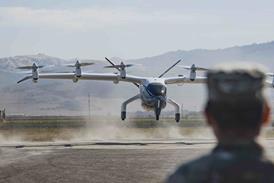DAIMLER-BENZ HAS COME in for a massive amount of criticism over its performance in the creation and subsequent stewardship of its aerospace subsidiary, DASA. In hindsight, it is perhaps all too clear that the big German vehicle manufacturer was being far too ambitious in simultaneously trying to build an international presence in aerospace and in electrical goods (through its take-over of AEG) in the late 1980s.
That criticism may not be justified in relation to Daimler-Benz' ambitions to create a three-legged industrial conglomerate - but that should not be confused with justifiable criticism of the strategy which Daimler-Benz has pursued with DASA.
Daimler-Benz has tried to consolidate the major parts of the German and Dutch aerospace industries into one strong unit. For that attempt, it should be praised, since Europe's industry is in need of every bit of consolidation possible. Unfortunately, Daimler-Benz has tried the wrong method at the wrong time, with the wrong intermediate goals.
The company apparently saw its goal as being the creation of a powerful German aerospace company, when what was needed was the integration of German skills and experience into a powerful European aerospace industry. In its pursuit of the wrong goal, Daimler-Benz made what were, in hindsight, some bad deals. It paid too much to acquire Dornier, in a deal, which had far too many strings attached, and it attempted to consolidate northern European regional-aircraft manufacture by taking effective control of Fokker.
In both cases it acquired fundamentally sound products, but (crucially) it also acquired costly, under-utilised, production sites. It was consolidating name-badges, but not manufacturing, so that it was deriving no economies of scale from its expansion - an error belatedly recognised by the Dolores report on DASA's restructuring.
True, it has entered into a series of joint ventures with Aerospatiale, especially in the fields of helicopters and missiles but joint ventures were not necessarily what was required. A joint venture is a good way of combining the strengths of two companies, but it also tends to combine their weaknesses, especially if one of those weaknesses is over-capacity.
The European aerospace industry, unfortunately, has far too much capacity for its current and foreseeable market share. Capacity will only be removed if companies go out of business, merge or are taken over. It is not a comforting suggestion, but the only consolidation, which is going to be of net benefit to the industry as a whole is one in which factories are shut. Joint ventures do not normally achieve that, nor do takeovers which have employment strings attached.
In the USA, there have been some very big, extremely brutal, consolidations in which combined companies have ended up with no more workers than either of the original constituents had, which means that the combined company ends up with the sales of two companies and the workforce of one. Such brutality runs counter to the European social conscience and ethos, but, without it, Europe will not survive with a credible industry.
True cross-border mergers and takeovers are still rare in Europe, but they will be needed, no matter how difficult the cultural or nationalistic barriers may be. By trying to consolidate within one country (Fokker notwithstanding), Daimler-Benz was only doing what had been done in the UK in the 1960s and 70s - and with as little initial success as attended the original formation of British Aerospace.
It may not have created what it wanted, but at least it has kept the German airframe-industry alive, so that the best of it can be incorporated in due course into what must eventually be just a couple of large, truly international, truly competitive European aerospace companies.
Source: Flight International




















